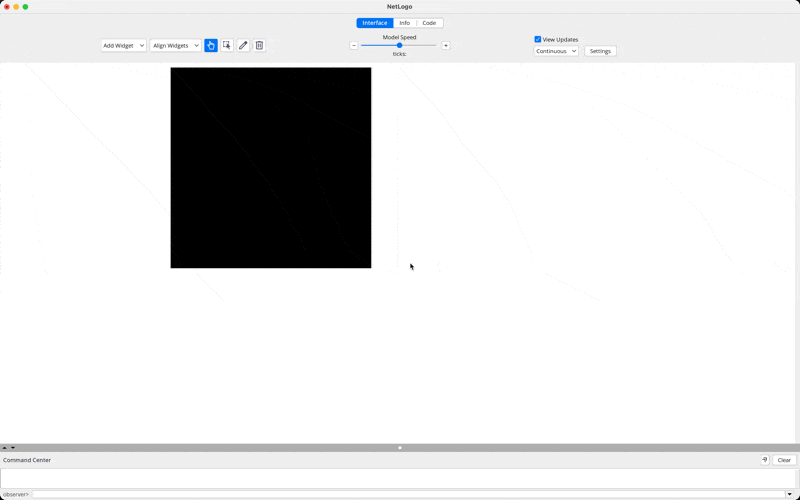It is always a good practice to start your model by setting up the environment and initializing the agents. In this section, we will create the setup procedure for our segregation model.
To do so, we want to make sure we understand the model we are creating. The intention is to build a grid of agents, where each agent has a color (red or blue) and a preference for the color of its neighbors. If an agent is unhappy with its neighbors, it will move to a new location.
The grid has a certain percentage of empty spaces, which allows agents to move around. The model will also include a slider to adjust the percentage of similar neighbors an agent wants in order to be happy.
For these reasons, the setup procedure will need to:
Clear the environment
Define the color of the patches
Create a certain number of agents (turtles) with random colors (red or blue) in each patch using the density as probability for an agent to be created
Update the characteristics of the agents (color, shape, size) based on their neighborhood
Define the global variables and update them based on the initial setup
We will need some global variables to keep track of the model’s state. These include:
similar-wanted: The percentage of similar neighbors an agent wants to be happy (controlled by a slider)density: The percentage of patches that will be occupied by agents (controlled by a slider)happy: The number of happy agents in the modelunhappy: The number of unhappy agents in the model
Notice that the similar-wanted and density variables will be controlled by sliders in the NetLogo interface, allowing us to easily adjust these parameters during the simulation.

Also, to account for the happiness of the turtles, we will create a variable called happy? for each turtle. This variable will be a boolean (true/false) indicating whether the turtle is happy or not based on its neighbors. We also want to make sure each agent (household) can keep track of the number of similar neighbors, different neighbors, and total neighbors it has. This will help us determine if the agent is happy or not.
Here is the code for the creation of global variables, the breed households, and the creation of attributes for our agents:
globals [
happy-households ; The number of happy agents in the model
unhappy-households ; The number of unhappy agents in the model
proportion-similarity ; proportion of similar households for the overall population
]
breed [households household] ; define a breed for the agents as a household
households-own [
happy? ; boolean indicating if the household is happy
similar-neighbors ; number of similar neighbors
different-neighbors ; number of different neighbors
total-neighbors ; total number of neighbors
similarity ; proportion of neighbors of the same color
]Now we can create the setup procedure. This procedure will clear the environment, set the patch colors, create the agents, and initialize their attributes. Also, we want the setup to include the initialization of the global variables. Before we start, it is important to note that we will be using procedures (functions) to organize our code better. This will make it easier to read and maintain.
Here is how you can implement it:
to setup
clear-all ; clear the environment
make-households ; procedure to create the households
update-households ; procedure to update the shape of the households based on their happiness
update-global-variables ; procedure to update the global variables
reset-ticks ; reset the tick counter
endThis is the procedure to create the households:
to make-households
ask patches [
set pcolor white ; set all patches to white
if random-float 100 < density [
sprout-households 1 [ ; create a household with a probability defined by density
set color one-of [red blue] ; randomly assign red or blue color
set size 1 ; set the size of the household
]
]
]
endFor now, we will create empty procedures for update-households and update-global-variables. We will fill them in the next sections.
to update-households
; This procedure will be filled in the next section
end
to update-global-variables
; This procedure will be filled in a later section
endFinally, we need to create a button in the NetLogo interface to call the setup procedure.

Now you can run the setup procedure by clicking the button, and it will initialize the model with a grid of agents (households) randomly assigned as red or blue, based on the density slider.